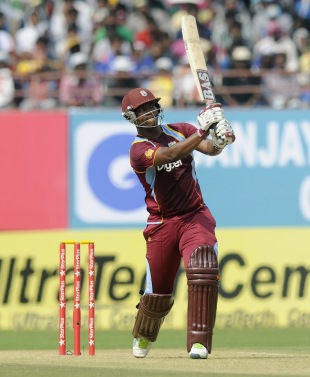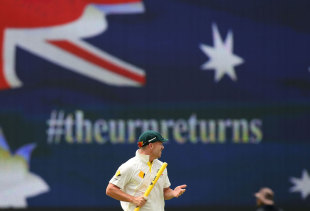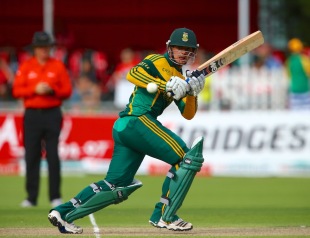West Indies were mostly sloppy and lacked the resilient spirit that had come to define their cricket in 2012
Garth Wattley January 5, 2014

Shane Shillingford was outstanding through 2013 and his suspension for an illegal bowling action was a body blow to West Indies cricket © WICB Media/Randy Brooks Photo
In 2012, West Indies were a team showing signs of improvement. Their efforts in 2013, however, represented definite backsliding. The cautious optimism the stakeholders in Caribbean cricket harboured at the turn of the year was quashed by a series of reversals. It was a year of regression.
The promising run of six consecutive Test wins that had began in 2012 in the Caribbean came to an abrupt halt in India and now West Indies have lost four of the their last five Tests. Unlike in 2012, there was no global title to celebrate. West Indies' journey in the Champions Trophy in England was ended by the combination of Duckworth-Lewis and an untimely Kieron Pollard dismissal before the semi-final stage.
They also had another losing one-day record, winning just nine of 24 matches. Their T20 showing was better: three wins and two losses. But it was the manner in which West Indies played, or rather, did not play, that was the real cause for concern.
In their seven Tests, they lost by an innings three times, including both matches on the belatedly arranged tour of India and then once more on the visit to New Zealand.
On home turf in the ODIs, after winning their opening two matches of the tri-nation series and seemingly well placed to reach the final, West Indies lost their remaining two games to India, the eventual winners, and Sri Lanka. In those matches and in the Test defeats, West Indies were sloppy and lacking the resilient spirit that had come to define their cricket in 2012.
The nucleus of the squad deployed in the various formats had not changed. The selectors attempted to show faith in the same group in the hope that the players would mature relatively quickly. They stuck faithfully with Kieran Powell, the Nevisian opener who had put together three centuries the previous year, including two in the same Test against Bangladesh. But Powell never reached those standards in 2013, ending it averaging an unsatisfactory 20.00.
The selectors had also introduced fast bowler Shannon Gabriel on the 2012 tour of England, and they gave him another go, following his recovery from a back injury, against Zimbabwe, India (as a replacement for Kemar Roach) and New Zealand. But after a promising effort against the newly reintroduced Zimbabweans in two Tests, he fell away so dramatically that he was out of the side for the final Test against New Zealand.
Roach and Ravi Rampaul, as productive a new-ball pair as West Indies have had since the retirements of Courtney Walsh and Curtly Ambrose, could not stay fit enough to share the new ball for anything like a sustained period. Rampaul was either unavailable because of injury, or simply not risked in any Test, while Roach - one of the world's leading bowlers in 2012 - managed just the two Tests against Zimbabwe. Andre Russell's form was such that he played only four ODIs and three T20s all year.
" Dwayne Bravo tried to bring energy and aggression to the one-day captaincy, but his lack of runs will have been a worry. Sammy's quiet year meant that his allrounder's spot remained under scrutiny
The absence of a settled bowling attack meant that by the latter part of the year, Darren Sammy's Test team had become overly dependent on Shane Shillingford's offspin; an option that ran out after his subsequent suspension from international cricket.
Just as debilitating to the team cause in the Test and one-day formats was the decline of Chris Gayle and Marlon Samuels. Gayle averaged 19-plus in an ODI season, and in the four Tests he played before a hamstring injury curtailed his year, he averaged 40. The bulk of those runs came against Zimbabwe. But in general, Gayle's runs were not influential or match-winning. His quick exits put extra pressure on his partners - Powell in the Tests, Johnson Charles in the ODIs, and No. 3 Darren Bravo in both formats.
Pollard started the year strongly in the ODI series in Australia, but faded before injury ended his season too. His made six scores of 0 in 17 one-day innings.
The lack of production from those pillars of the team may have been due to a variety of reasons. But those failures gave the less established support cast the chance to embrace more responsibility. They did not quite do that. And that collective inability to handle the extra pressure and add quality to their individual games was as much the reason for West Indies' disappointing year as anything else.
Darren Bravo was fairly consistent in the ODIs, with one century and six fifties. But he needed to make more of some of those good starts. His double-century in the Dunedin Test was the highlight of a disappointing Test match run. It was an innings constructed under great pressure and was the difference between an honourable draw and a heavy defeat. However, two failures followed in Wellington. It is the sustained production of innings of both quantity and quality that the selectors still anxiously await.
His captains - Sammy in the Tests and T20s and brother Dwayne in the ODIs - badly need the support. Their own 2013 form was below par and neither could compensate for their failures in other departments of the game. Bravo, given the one-day captaincy, tried to bring energy and aggression to the job. But his lack of runs will have been a worry. Sammy's quiet year, with the ball especially, meant that his allrounder's spot remained under scrutiny.
Unsurprisingly, the veteran Shivnarine Chanderpaul, now past 11,000 Test runs, was one of the precious few who maintained his level of performance, as did the offspinner Sunil Narine in ODIs and T20s. His six-wicket haul in his sole Test of the year also boosted what has been a slow start to his Test career.
Apart from those two, wicketkeeper-batsman and vice-captain Denesh Ramdin quietly shored up his place in the Test side in 2013. His century under pressure in the final Test against New Zealand contributed to a healthy average of 45.55 for the year. Three centuries in the last 18 months represent encouraging returns. At least in his case, the report card could be marked "improved".

Johnson Charles improved his credentials as an opening batsman in the shorter formats in 2013 © BCCI
High point
The biggest ray of sunshine was provided by the inaugural season of the Caribbean Premier League. The T20 franchise series captivated the public across the region, without exception. It brought atmosphere and fresh enthusiasm to grounds long devoid of those ingredients. It provided more work for players in the Caribbean, brought a few more into the limelight, and demonstrated the potential to get more youngsters genuinely interested in the game.
Low point
The three innings defeats, especially the two in India in Sachin Tendulkar's farewell series, were alarming and dispiriting. But Shilingford's suspension from international cricket for a second time for an illegal action summed up West Indies' year. The offspinner was prolific, bagging 36 wickets to emerge in 2013 as a bowler the team could rely on. His removal was a body blow, not only for the player but the team as a whole. It was a case of one stride forward, three well back.
New kid on the block
It was not his first year of international cricket, but Johnson Charles improved his credentials as an opening batsman in the shorter formats with some substantial innings. He chose a tough tour to Australia in which to score his maiden ODI century, in a series the tourists lost 5-0. He followed an even 100 in Melbourne in February with 130 against Zimbabwe later that same month. More prudent shot selection bore results for this fearless attacker. But choice of shots and choice of time to play them is an area that Charles will have to work on if he is to become a true asset to the side.
Fading star
Samuels, so outstanding for his focus in 2012, had a slow start to the year because of an eye injury. He never caught himself and did not seem to have the same resolve at the crease that had defined his batting in 2012. A chronic wrist problem, which eventually caused him to leave the New Zealand tour ahead of the limited-overs series, may have had something to do with some of those failures. Now that he is almost 33, there ought to be at least two good years left for Samuels to use his obvious gifts in West Indies' cause. The big question, however, is whether the motivation he seemed to lack in 2013 will return.
What 2014 holds
West Indies stumbled through the last two months of 2013 giving off a sense of insecurity and uncertainty that has come to define too many seasons.
For once, friction between the administrators and the players' body was not a source of turmoil. New leadership on both sides has brought more civil, less public exchanges. The Caribbean Premier League also put some wind in the sails of the WICB ship. But the disastrous results in India and New Zealand at the end of the year were a reminder of the rough waters West Indies cricket is still in.
The Darren Sammy-Ottis Gibson captain-coach combination that had coaxed, spirited and committed cricket from their charges in 2012, did not do the same in 2013. Darren Bravo's departure from the West Indies ODI series for "personal reasons" still unexplained at the time of writing, left room for unhealthy speculation. And comments about a lack of team unity by his brother, ODI skipper Dwayne, when he joined the tour, pointed to a team in crisis. In his comments after the Test series in New Zealand, Sammy, an admirable leader in many respects, sounded like a man who had reached his limit.
His time at the helm could well be at an end. But what new WICB president Dave Cameron and his board directors must also realise is that Sammy has done the best he could with what he has had to work with. The failures of technique and application that led to embarrassment and disappointment this year, were a reflection not just on individuals but of the problems existing at grass-roots level in the Caribbean. That state of play will not be changing in 2014.
Cameron boldly said back in June: "Anything that I am able to achieve in my presidency will be as a result of what we were able to achieve on the field."
He should brace himself for some trying times.














